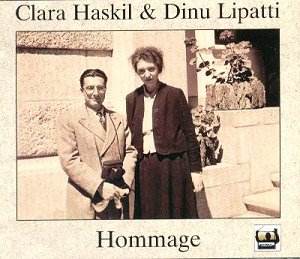AVAILABILITY
www.tahra.com
The unusual nature of the relationship between these
two great Romanian pianists is described in some detail in the extensive
booklet notes written by Clara Haskil’s biographer Jérome Spycket.
The oscillatory affection, devotion and eventual loss is sensitively
told and adds an even richer, more humanly complex layer to their lives.
It is apt and just documentation for a set of historical significance
and if in the final balance it is the Haskil disc that provides the
more revealing material – because many are previously unissued recordings
– the confluence of the two is no less important for the light they
shed on each other.
The unpublished Haskil material seems to date from
1928 to 1958. I say ‘seems’ because there seems to be some confusion
surrounding it in the booklet notes and I’ve made little headway tracking
it down. I think the Abegg Variations at least derive from a commercial
recording because Haskil made a little popularized set of discs for
Polydor in the 1930s and Polydor 561121 contains the Schumann. It’s
possible that other sides here derive from commercial discs as well
but the Beethoven extract is a rehearsal segment and the Mozart Concerto
is a live recording from 1954, preserved by German radio. The Chorale
Prelude was also recorded live, at Ludwigsburg Castle. Irrespective
of their provenance there are plenty of things to intrigue the Haskil
devotee. In Liszt’s La Leggierezza she engages in some rather
rhetorical rubati even though there is some scintillating clarity in
the right hand and it’s a real pity that the recording ends abruptly
losing some bars at the conclusion. Carl Heinrich Graun’s Gigue used
to be a bit of a repertoire piece and one can see why; it has a sturdy
charm, flecked by moments of wit that give it a winning profile. Tahra
have had to work with a less than pristine copy here with a relatively
high degree of surface noise and occasional fortissimi overload. The
Poulenc Presto – blink and you miss it – was popular with Horowitz and
others but again a rather battered copy has had to be used. Brahms’
Capriccio is however full of discursive romanticism, its alternate drive
and unease conveyed with a tension inducing control. Similarly the Intermezzo
is full of sensitive shaping. She runs through parts of the second Beethoven
Concerto – most unusual and fascinating to eavesdrop on her in this
unvarnished, intimate context. The Abegg Variations, always one of her
stellar performances, receives a remarkable and all-encompassing sweep.
Tonally and expressively, in terms of rhythmic attack and judicious
weight, in response to drama, external and internal, this is a triumphant
performance. Bavarian Radio taped her Mozart Concerto in 1954 in quite
serviceable though hardly luxuriant sound. There’s no bloom to the acoustic
and an occasional dimness to the sound perspective but no matter – the
first movement has her usual clarity and decisiveness, the Andantino
a simplicity born of directness of utterance. The finale is full of
vivacity but also a singular charm and wit hard to resist. Haskil’s
disc ends with Nun komm’ der Heiden Heiland, taped in 1953, a noble
way to end her contribution and – a touching moment – Lipatti’s disc
begins with the same Chorale Prelude, recorded for HMV in 1947.
If I spend less time on Lipatti it’s because the items
on his disc are more known quantities. The commercial Bach is augmented
by three interviews with Lipatti conducted in Switzerland, where he
was living, in 1950 - a few months before his death. These are scripted,
as was the custom, and one can hear Lipatti’s heavily accented French
and have the advantage of the translations being printed in the booklet.
The Bartók Concerto has appeared before – it’s available on EMI
CDM5 66988-2 (coupled with the Bach-Busoni First Concerto and the First
Liszt) and that EMI issue is in slightly better sound than this one.
The performance took place in Baden-Baden in 1948 with Paul Sacher conducting
the orchestra of South West German Radio. Though the recording has some
(surmountable) problems the reading is cool and clear, with a slow movement
of almost pellucid beauty from Lipatti, his tone colours of devastating
candour. Finally there is Lipatti’s own Sonatine for the Left Hand,
a remarkable wartime Romanian radio recording. This little eight-minute
work runs the gamut of neo-classical wit (the opening Allegro), affectionate
and sophisticated depth (the slow movement marked Andante religioso)
and folk-like boisterousness (the Allegro vivace finale).
This then is a set of some significance. Sometimes
the sound is less than optimum but that is a price well worth paying
to acquire some unique performances. Lipatti’s many admirers will want
to hear his speaking voice (at least I hope they will) as well, obviously,
as the Sonatine and should they not already have it, the Bartók.
Devotees of Haskil have been increasingly well served over recent years
but will still find this a treasure trove of rare material. In its touching
eloquence this set also reflects something of the turbulence of time,
place and consequence which dogged, pursued and finally overwhelmed
these two irreplaceable artists.
Jonathan Woolf



